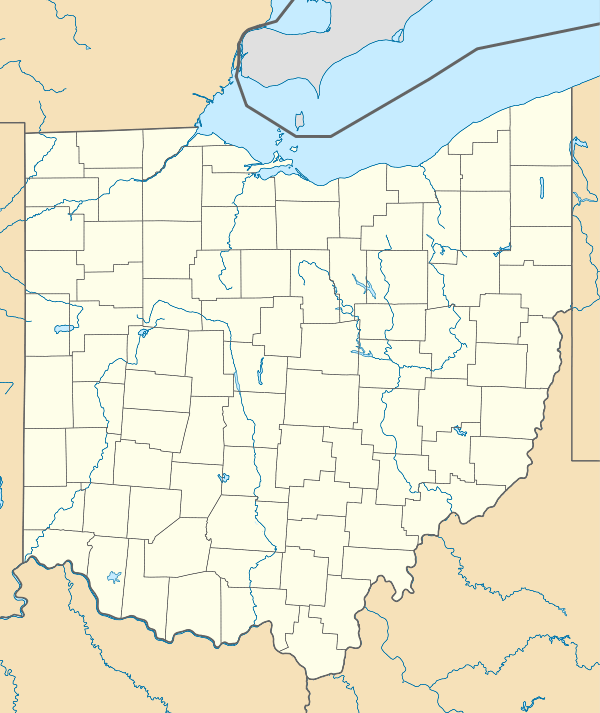Ohio State University Airport
Coordinates: 40°04′47″N 083°04′23″W / 40.07972°N 83.07306°W
| Ohio State University Airport | |||||||||||||||||||
|---|---|---|---|---|---|---|---|---|---|---|---|---|---|---|---|---|---|---|---|
|
| |||||||||||||||||||
| IATA: OSU – ICAO: KOSU – FAA LID: OSU | |||||||||||||||||||
| Summary | |||||||||||||||||||
| Airport type | Public | ||||||||||||||||||
| Owner | Ohio State University | ||||||||||||||||||
| Location | Columbus, Ohio | ||||||||||||||||||
| Elevation AMSL | 905 ft / 276 m | ||||||||||||||||||
| Website |
www | ||||||||||||||||||
| Map | |||||||||||||||||||
 OSU  OSU Location of airport in Ohio/United States | |||||||||||||||||||
| Runways | |||||||||||||||||||
| |||||||||||||||||||
| Helipads | |||||||||||||||||||
| |||||||||||||||||||
| Statistics (2005) | |||||||||||||||||||
| |||||||||||||||||||
Ohio State University Airport (IATA: OSU, ICAO: KOSU, FAA LID: OSU) is a public airport six miles (10 km) northwest of downtown Columbus, in Franklin County, Ohio.[1] It is owned and operated by The Ohio State University in Columbus, not to be confused with Ohio University in Athens, which owns the Ohio University Airport (IATA: ATO, ICAO: KUNI, FAA LID: UNI).[1] It is also known as the OSU Don Scott Airport, named after Donald E. Scott, an OSU alumnus who died during his training as a pilot in England during World War II.
The Ohio State University Airport (OSU) serves the university while offering general aviation services for the public.
The OSU Airport began in 1943 as a flight training facility for military and civilian pilots, operated by the OSU School of Aviation. The OSU Airport is now a self-supporting entity of The Ohio State University through the Department of Aerospace Engineering & Aviation.
The Department oversees all aspects of the Airport from Airport Management, to Fixed-Base Operations, to Airport Maintenance.
The OSU Airport is a Part 139 Certificated Airport, serving as a general aviation reliever for the nearby Port Columbus International Airport.
The OSU Airport is home to 230 aircraft, including single- and multi-engine, piston, and turbine engine aircraft and rotorcraft. It oversees about 100,000 operations per year and generally ranks in the top five airports in Ohio in the number of take-offs and landings with Cleveland Hopkins, Port Columbus, Dayton, and Cincinnati Lunken.
The Airport is also home to the OSU Department of Aerospace Engineering & Aviation Gas Turbine Laboratory, several facilities operated by the OSU College of Agriculture, the Ohio Department of Transportations Office of Aviation, fourteen corporate flight departments, and four flying clubs.
In 1967 the crew of a TWA 707 mistook the Ohio State University Airport for Port Columbus International Airport. After shuttling all passengers and baggage to Port Columbus, and removing all galley equipment and seats, the plane was light enough to depart for the larger airport across town.[3]
Serving the business community

The airport serves the expanding north outerbelt of Columbus and the new commercial centers in Worthington, Dublin, and Hilliard. It is a link between the central Ohio business community and their destinations; businesses benefit from a brief two-hour flight to 60% of the nation's population, 60% of the nation's manufacturing, and 60% of the nation's purchasing power.
In a recent study, the OSU Airport was estimated to contribute roughly $103.6 million annually to the region's economy through direct and indirect means. Direct impacts include the payroll of airport personnel, revenues and taxes received through the sale of aviation fuel and pilot supplies, and revenues generated by the leasing of airport property. Indirect impacts are generated when airport users visit local restaurants, stay at local hotels, and rent cars for off-airport travel.
References
- 1 2 3 FAA Airport Master Record for OSU (Form 5010 PDF), effective 2007-07-05
- ↑ Ohio State University Airport (official site)
- ↑ "Columbus Mileposts: July 4, 1967 | A terrific landing, but at the wrong airport". Retrieved 2016-09-14.
External links
- Historic photo; Don Scott field in 1954
- Historic photo; Don Scott field in 1983
- FAA Airport Diagram (PDF), effective December 8, 2016
- Resources for this airport:
- FAA airport information for OSU
- AirNav airport information for KOSU
- ASN accident history for OSU
- FlightAware airport information and live flight tracker
- NOAA/NWS latest weather observations
- SkyVector aeronautical chart, Terminal Procedures